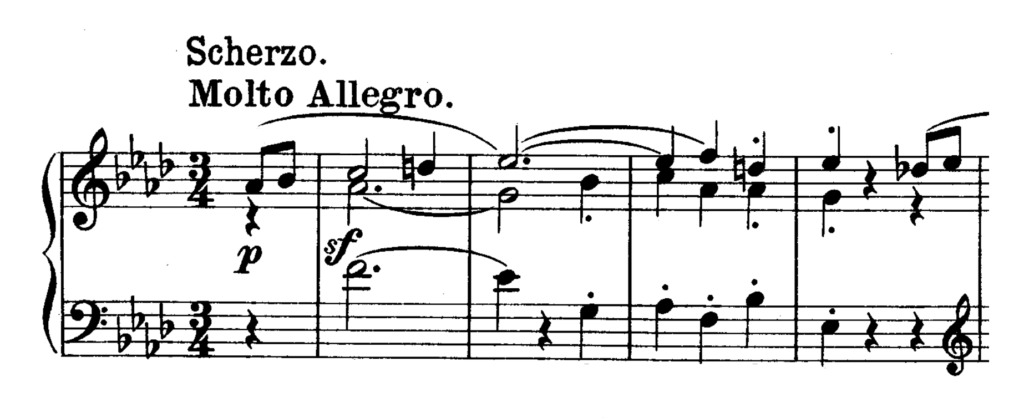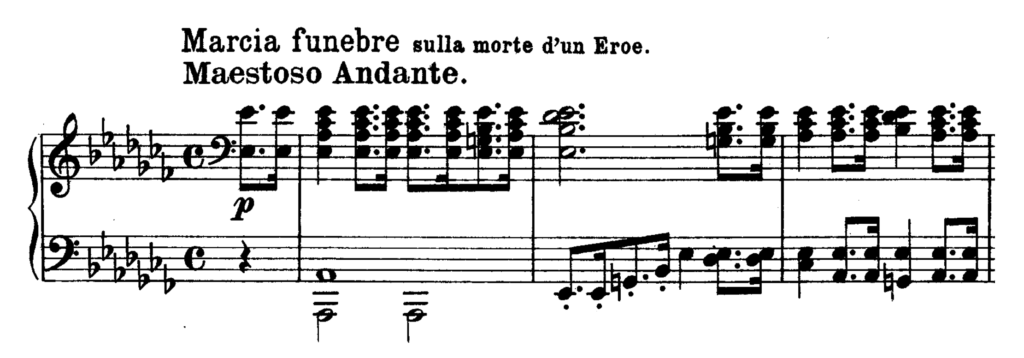Analysis
Contents
For the benefit of all pianists learning this work, we present to you a concise and easy to use analysis of Beethoven’s Piano Sonata No.12 in Ab major.
First Movement (Andante Con Variazioni)
Form: Air with Variations. Ab Major.
The first movement is not in regular Sonata form; the only other exceptions are Op. 27, No. 1 and No. 2; Op. 54, and Op. 109. There is no movement is Sonata form in Op 26.
AIR:
Bars 1-35: Key of A flat major. The “Air” is composed of two sections of eight bars each, Bars 1-9 and 9-17, ending on full close in the tonic; it is followed by two bars in B flat minor, Bars 17-19; treated in sequence, Bars 19-21; and six bars modulating to the dominant, Bars 21-27, after which the second section of the air is repeated (Bars 28-35).
FIRST VARIATION:
Bars 1-35: Key of A flat major. Characterized by a demisemiquaver (thirty-second note) figure which pervades it.
SECOND VARIATION:
Bars 1-35: Key of A flat major. The “Air” (varied) appears in the bass.
THIRD VARIATION:
Bars 1-35: Key of A flat minor. Syncopation is employed throughout
FOURTH VARIATION:
Bars 1-35: Key of A flat major. Syncopation is freely used. The principal accent occurs on the third beat of each bar.
FIFTH VARIATION:
Bars 1-35: Key of A flat major.
Bars 36-End: Coda. At the close of the variation there is a Coda, Bar 36 to the end.
Second Movement (Scherzo – Allegro Molto)
Form: Ternary Form. Ab Major.
FIRST PART: A
The First Part is in Simple Binary form.
Bars 1-17: First subject begins in E flat major, ends in A flat major (tonic). The first subject begins in the key of the dominant instead of in the tonic (see also “Allegretto,” Op. 27, No. 2); Bars 1-9 are repeated (varied), Bars 9-17.
Double bar.
Bars 18-46: Episode. The Episode begins with a sequence of eight bars formed upon the first subject.
Bars 46-62: First subject (varied) in original keys. The first subject re-appears in the bass, with a running quaver (eighth note) accompaniment in the treble; it afterwards (Bar 54) appears in the treble, the quaver accompaniment being in in the bass.
Bars 62-End of Part I: Coda.
Double bar and repeat from Bar 18.
SECOND PART:
Bars 1-9: First Subject in D flat major, ending in A flat major.
Bars 10-26: Episode. This sequential episode is formed on the rhythm of the first subject.
Double bar and repeat from Bar 10.
Bars 27-31: A modulating passage of four bars that leads back to the resumption of the first subject.
THIRD PART:
First part da capo.
Third Movement (Maestoso Andante – Marcia Funebre Sulla Morte D’un Eroe)
Form: Ternary Form. Ab Minor.
FIRST PART:
Bars 1-31: Subject in A flat minor (tonic). The first subject commences in A flat minor, it modulates (Bar 8) to C flat (relative major), at Bar 10 to B minor, at Bar 16 to D major, and Bar 19 to E flat major. At Bar 22 the first part of the subject is repeated altered so as to end in A flat minor (tonic)
SECOND PART:
Bars 32-40: Subject in A flat major. The second part is divided into tow portions of four bars each (both repeated), the formed of which ends in the key of E flat major.
THIRD PART:
Bars 40-70: Repetition of first part.
Bars 70-End: Coda. Note the double counterpoint, Bars 70-73. The part next the bass, Bars 70-71, is in the treble, Bars 72-73, and the treble of Bars 70-71 is in the part next the bass, Bars 72-73. The whole of the Coda is upon a pedal point.
Fourth Movement (Rondo: Allegro)
Form: Rondo Form.Ab Major.
FIRST PART:
Bars 1-29: First Subject in A flat major (tonic). The first subject is curiously constructed; the first portion of it, to Bar 13, is in three-bar rhythm, the last portion, Bars 13-29, is in two bar rhythm (expecting Bars 17-21, which are in four-bar rhythm); it abounds in inversions and imitations.
Bars 29-33: Episode. The episode is composed of a sequence formed on the first subject; Bars 29-31 are repeated in the treble, Bars 31-33, a twelfth higher.
Bars 33-49: Second Subject in E flat major. The second subject is accompanied by the first subject figure.
Bars 49-53: The beginning of the short passage on the dominant pedal furnishes the material for the third subject; it simply leads from the key of the dominant to the key of the tonic.
Bars 53-81: First Subject in original key.
SECOND PART:
Bars 81-98: Third Subject in C minor, ending in E flat major. The third subject commences in C minor. At Bar 89 it modulates to G minor (Bars 82-89 are repeated). After modulating to the key of F minor it ends, Bar 98, in E flat major.
Bars 98-102: Bars 98-102 form a passage resembling somewhat that at Bars 49-52
THIRD PART:
Bars 102-130: First Subject in original key.
Bars 130-140: Episode. This episode is very like that at Bars 29-33, extended. Instead of ending in B flat major, it ends on the dominant key of the tonic.
Bars 140-156: Second Subject in A flat major (tonic).
Bars 156-End: Coda. The Coda is constructed upon tonic pedal point and formed upon the first subject.










